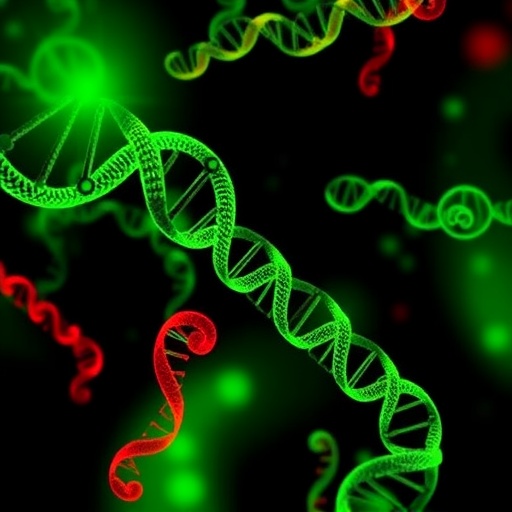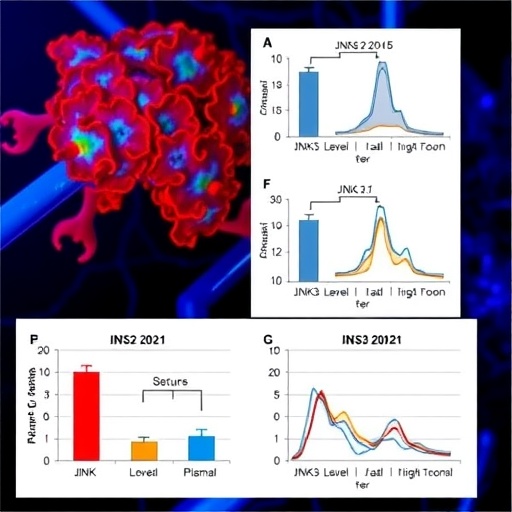In a major leap forward for molecular diagnostics, scientists have developed a novel CRISPR-based assay that significantly enhances the sensitive detection of pathogen DNA. This breakthrough revolves around the use of a multi-guide RNA Cas12a system that preferentially promotes trans-cleavage activity over the traditional cis-cleavage mode, resulting in unprecedented sensitivity and specificity. The innovative approach, recently reported in Nature Communications, is poised to revolutionize infectious disease diagnostics by enabling rapid and highly accurate identification of pathogenic DNA sequences at extremely low concentrations.
CRISPR-Cas systems, originally discovered as adaptive immune defenses in bacteria, have rapidly evolved into versatile tools for genome editing and molecular detection. Cas12a, a member of the type V CRISPR family, is remarkable for both its programmable DNA-targeting ability and its collateral cleavage activity, in which after binding its specific target sequence, it non-specifically cleaves single-stranded DNA molecules nearby. This collateral or ‘trans-cleavage’ property has been harnessed in diagnostic platforms to amplify detection signals, transforming Cas12a into a powerful biosensing platform.
However, a persistent challenge limiting the sensitivity of Cas12a-based assays has been the balance between cis-cleavage (the direct cutting of the target DNA) and trans-cleavage (the collateral degradation used for signal amplification). Typically, the cis-cleavage occurs first, detaching the guide RNA-Cas12a complex from the target DNA, which can reduce collateral activity and thus diminish the overall signal strength. Addressing this kinetic bottleneck, the study led by Huang et al. presents a multi-guide RNA strategy that strategically biases Cas12a towards enhanced trans-cleavage, maximizing signal output and detection sensitivity.
The team designed an assay employing multiple guide RNAs, each targeting distinct sites on the pathogen DNA. This multiplex approach ensures sustained activation of Cas12a’s trans-cleavage function by providing repeated target engagement opportunities. By simultaneously engaging multiple genomic loci, the system maintains Cas12a in an activated state longer, overcoming the transient nature of single-guide interactions. The outcome is a significant amplification of the collateral cleavage signal, enabling the detection of extremely low abundance DNA molecules that would otherwise evade conventional assays.
Underlying this method is a sophisticated understanding of Cas12a enzymology and kinetics. The researchers carefully examined how guide RNA multiplicity alters Cas12a’s cleavage dynamics. Their data revealed that multi-guide RNA loading not only increased the enzyme’s dwell time on target DNA but also created a kinetic environment favoring robust trans-cleavage over cis-cleavage. This mechanistic insight underpins the assay’s dramatic sensitivity improvements, which could have broad implications for pathogen detection in clinical and environmental samples.
Moreover, the assay design incorporates strategic bioinformatics to select guide RNAs that minimize off-target effects while maximizing coverage of pathogen genomes. This ensures high specificity, critical for avoiding false positives in complex sample backgrounds. The ability to distinguish closely related DNA sequences with exceptional accuracy positions this multi-guide RNA Cas12a assay as a superior alternative to existing PCR and isothermal amplification techniques, which often suffer from primer-dimer artifacts and lower multiplexing capacity.
Experimental validation was conducted using a diverse panel of infectious agents, demonstrating that the assay not only detects target DNA at femtomolar concentrations but does so with remarkable reproducibility and speed. The reaction completes within minutes under isothermal conditions, making it well-suited for point-of-care diagnostics where rapid decision-making is crucial. Importantly, the streamlined workflow requires minimal sample processing and standard laboratory equipment, lowering the barrier for widespread implementation.
A particularly compelling aspect of this development is its adaptability. The modular nature of guide RNA design allows swift reconfiguration of the assay to monitor emerging pathogens or detect mutations conferring drug resistance. As infectious disease landscapes evolve, the capacity to quickly deploy ultra-sensitive diagnostic tools will be instrumental in outbreak containment and patient treatment optimization.
Additionally, the improved signal-to-noise ratio from enhanced trans-cleavage translates to the potential for simple readout systems, including fluorescent or colorimetric outputs that can be visualized without complex instrumentation. This feature paves the way for affordable, user-friendly diagnostics accessible in resource-limited settings, bridging gaps in global health surveillance and response.
Beyond infectious diseases, the principles elucidated with this multi-guide RNA Cas12a assay open avenues for detecting genetic biomarkers relevant to cancer, genetic disorders, and environmental monitoring. The platform’s intrinsic versatility underscores the broad utility of CRISPR-based diagnostics as a transformative technology across biomedical disciplines.
The inclusion of real-time monitoring to track cleavage kinetics further advances our mechanistic understanding, enabling refinement of guide RNA combinations and reaction conditions for tailored applications. This precision engineering harnesses the full enzymatic potential of Cas12a, pushing the boundaries of sensitivity and specificity in nucleic acid detection.
Overall, the novel multi-guide RNA Cas12a assay capitalizes on molecular synergies that amplify detection capabilities far beyond current standards. Huang and colleagues’ work exemplifies the intersection of molecular biology, bioengineering, and diagnostic innovation, setting a new benchmark for pathogen DNA sensing that promises to accelerate both research and clinical workflows.
As CRISPR-based tools continue to mature, this study highlights the untapped potential within Cas enzyme kinetics that can be manipulated to create next-generation diagnostics. The focus on tuning cleavage activity—particularly favoring trans- versus cis-cleavage—represents a paradigm shift in how these enzymes can be deployed for molecular detection.
Looking forward, integrating this assay with microfluidic platforms and automated sample handling could yield fully integrated, portable diagnostic devices slashing turnaround times from hours to minutes. Such technology would be especially impactful during emerging global health emergencies requiring rapid, decentralized testing solutions.
Furthermore, combining this multi-guide RNA Cas12a system with other CRISPR effectors or amplification strategies could enhance multiplexing and allow simultaneous detection of multiple pathogens or genetic variants within a single test—a powerful capability to navigate complex diagnostic landscapes.
The study’s findings also prompt deeper exploration into CRISPR dynamics, encouraging researchers to exploit other enzymes’ cleavage properties strategically. This could inspire a wider suite of highly sensitive and programmable molecular diagnostic assays tailored to diverse clinical and environmental needs.
In conclusion, the multi-guide RNA Cas12a assay introducing a preferential trans-cleavage activation mechanism is a landmark advancement in nucleic acid detection technology. By elegantly engineering guide RNA arrays to harness Cas12a’s collateral cleavage potential fully, Huang and colleagues have unlocked powerful new diagnostic possibilities destined to reshape infectious disease detection, molecular medicine, and beyond.
Subject of Research: Sensitive detection of pathogen DNA using a novel CRISPR-Cas12a-based assay with multi-guide RNAs designed to favor trans-cleavage over cis-cleavage activity for enhanced sensitivity.
Article Title: Sensitive pathogen DNA detection by a multi-guide RNA Cas12a assay favoring trans- versus cis-cleavage.
Article References:
Huang, Z., Song, Z., Zeng, J. et al. Sensitive pathogen DNA detection by a multi-guide RNA Cas12a assay favoring trans- versus cis-cleavage. Nat Commun 16, 8257 (2025). https://doi.org/10.1038/s41467-025-63094-x
Image Credits: AI Generated
Tags: Cas12a CRISPR family applicationscollateral cleavage in biosensingCRISPR-based pathogen detectionenhanced DNA detection sensitivityinfectious disease diagnosticslow concentration DNA detectionmolecular diagnostics innovationmulti-guide RNA Cas12a systemprogrammable DNA-targeting technologyrapid diagnostic methods for pathogensspecific pathogen identificationtrans-cleavage activity in assays





